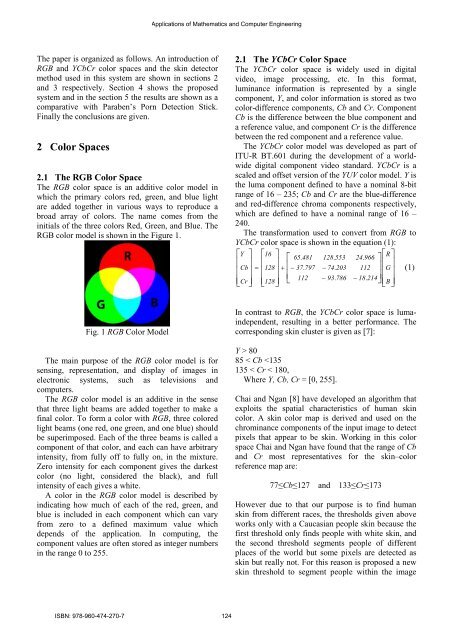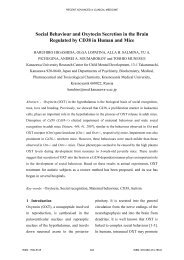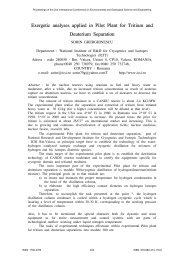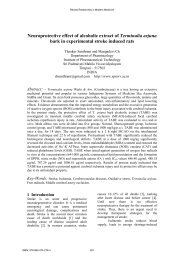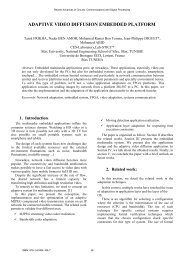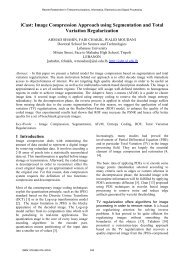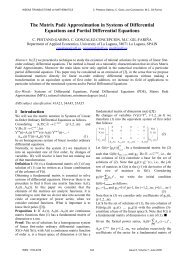Explicit Image Detection using YCbCr Space Color ... - Wseas.us
Explicit Image Detection using YCbCr Space Color ... - Wseas.us
Explicit Image Detection using YCbCr Space Color ... - Wseas.us
You also want an ePaper? Increase the reach of your titles
YUMPU automatically turns print PDFs into web optimized ePapers that Google loves.
The paper is organized as follows. An introduction of<br />
RGB and <strong>YCbCr</strong> color spaces and the skin detector<br />
method <strong>us</strong>ed in this system are shown in sections 2<br />
and 3 respectively. Section 4 shows the proposed<br />
system and in the section 5 the results are shown as a<br />
comparative with Paraben’s Porn <strong>Detection</strong> Stick.<br />
Finally the concl<strong>us</strong>ions are given.<br />
2 <strong>Color</strong> <strong>Space</strong>s<br />
2.1 The RGB <strong>Color</strong> <strong>Space</strong><br />
The RGB color space is an additive color model in<br />
which the primary colors red, green, and blue light<br />
are added together in vario<strong>us</strong> ways to reproduce a<br />
broad array of colors. The name comes from the<br />
initials of the three colors Red, Green, and Blue. The<br />
RGB color model is shown in the Figure 1.<br />
Fig. 1 RGB <strong>Color</strong> Model<br />
The main purpose of the RGB color model is for<br />
sensing, representation, and display of images in<br />
electronic systems, such as televisions and<br />
computers.<br />
The RGB color model is an additive in the sense<br />
that three light beams are added together to make a<br />
final color. To form a color with RGB, three colored<br />
light beams (one red, one green, and one blue) should<br />
be superimposed. Each of the three beams is called a<br />
component of that color, and each can have arbitrary<br />
intensity, from fully off to fully on, in the mixture.<br />
Zero intensity for each component gives the darkest<br />
color (no light, considered the black), and full<br />
intensity of each gives a white.<br />
A color in the RGB color model is described by<br />
indicating how much of each of the red, green, and<br />
blue is included in each component which can vary<br />
from zero to a defined maximum value which<br />
depends of the application. In computing, the<br />
component values are often stored as integer numbers<br />
in the range 0 to 255.<br />
Applications of Mathematics and Computer Engineering<br />
ISBN: 978-960-474-270-7 124<br />
2.1 The <strong>YCbCr</strong> <strong>Color</strong> <strong>Space</strong><br />
The <strong>YCbCr</strong> color space is widely <strong>us</strong>ed in digital<br />
video, image processing, etc. In this format,<br />
luminance information is represented by a single<br />
component, Y, and color information is stored as two<br />
color-difference components, Cb and Cr. Component<br />
Cb is the difference between the blue component and<br />
a reference value, and component Cr is the difference<br />
between the red component and a reference value.<br />
The <strong>YCbCr</strong> color model was developed as part of<br />
ITU-R BT.601 during the development of a worldwide<br />
digital component video standard. <strong>YCbCr</strong> is a<br />
scaled and offset version of the YUV color model. Y is<br />
the luma component defined to have a nominal 8-bit<br />
range of 16 – 235; Cb and Cr are the blue-difference<br />
and red-difference chroma components respectively,<br />
which are defined to have a nominal range of 16 –<br />
240.<br />
The transformation <strong>us</strong>ed to convert from RGB to<br />
<strong>YCbCr</strong> color space is shown in the equation (1):<br />
⎡Y<br />
⎤ ⎡16<br />
⎤ ⎡ 65.<br />
481 128.<br />
553 24.<br />
966 ⎤⎡R<br />
⎤<br />
⎢ ⎥ ⎢ ⎥ ⎢<br />
⎥⎢<br />
⎥<br />
Cb = 128 + − 37.<br />
797 − 74.<br />
203 112 G (1)<br />
⎢ ⎥ ⎢ ⎥ ⎢<br />
⎥⎢<br />
⎥<br />
⎢⎣<br />
Cr⎥⎦<br />
⎢⎣<br />
128⎥⎦<br />
⎣ 112 − 93.<br />
786 − 18.<br />
214⎦⎢⎣<br />
B⎥⎦<br />
In contrast to RGB, the <strong>YCbCr</strong> color space is lumaindependent,<br />
resulting in a better performance. The<br />
corresponding skin cl<strong>us</strong>ter is given as [7]:<br />
Y > 80<br />
85 < Cb


